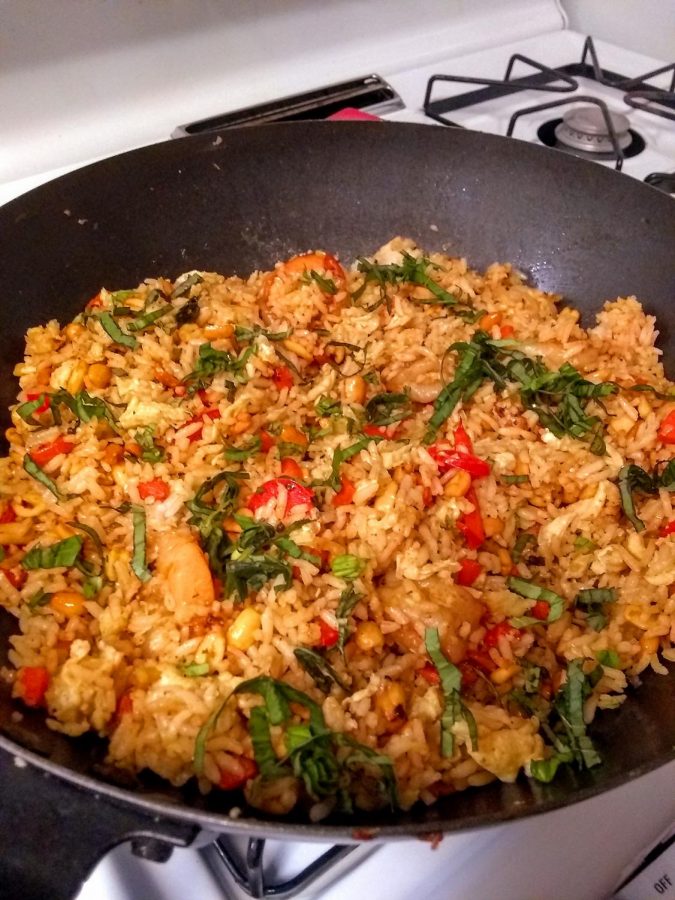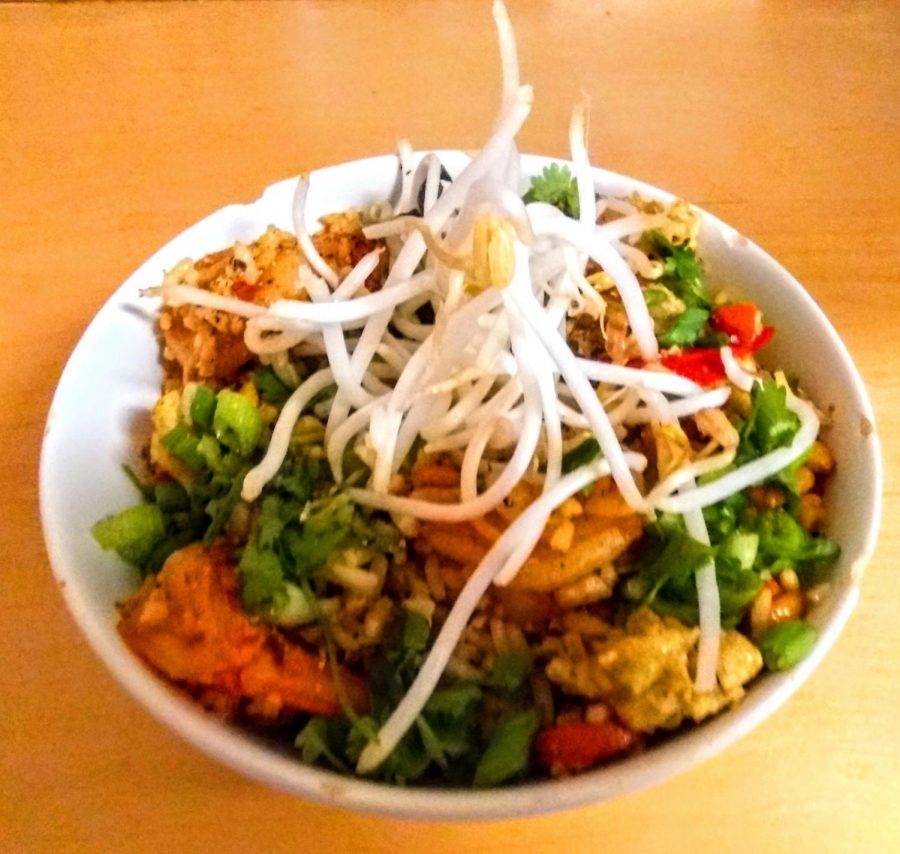Happy belated Lunar New Year! It’s the Year of the Ox – dedicated, hardworking and resilient describe this cycle.
Similarly, this dish requires attention and discipline. Fear not! This is the season for spicy, sweet, and hearty dishes, especially when you can make enough to last for a few days.
Stir-fry is easy, quick and versatile — easily my favorite kitchen word. Sure, some proteins are more appropriate than others — I don’t recommend salmon — and there are definitely better veggies than others — can’t do without carrots, in my opinion. This is less a recipe than it is a set of guidelines, a short list of suggestions to kick up your stir-fry game.
What I’ve seen less represented in stir-fry are fruits and nuts, both of which add more of a dynamic than meats and vegetables ever could alone.

PREP TIME
If you’re a slow chopper, plan for 30-40 minutes
Cook time: 5-8 minutes
Total time: 35-50 minutes
Serves: Adjustable portions, it depends on how much leftovers you want
EQUIPMENT
Kitchen knife
Cutting board
Multiple bowls for prep portions
Wok, preferably with a lid*
Rubber spatula
Fork for whisking (I rarely use a whisk; forks usually work just fine)
*Every time I thought a skillet or wide flat pan could cut it, my stir-fry always ended up mushy and unevenly cooked. A wok is a must because its bowl-like structure redirects heat inward, allowing for a quick cooking time. If you’re on a budget, woks can be found for $30 or less at Walmart — though I wouldn’t pay less than $30 for one. Some degree of quality is in your best interest. For more wok information, please see notes below.
INGREDIENTS
Typical stir-fry ingredients include bell peppers, broccoli, carrots, cauliflower, cilantro, eggs, garlic, ginger, green beans, green onions, mushrooms, nuts, peas and soy sauce.
I never skip out on bell peppers, carrots, eggs, garlic, ginger, or green onions. Beyond that preference, I just add whatever’s handy.
For proteins: seafood in stir-fry is mostly limited to crustaceans, shrimp, lobster, and crab, for example, but these are the most delicate and should be watched carefully. Pork chop, tenderloin, chicken, tender beef cuts and lamb are all fantastic.
Oil: I prefer two oils — coconut oil for the egg and sesame oil for the rest. Whatever oil you choose, make sure it’s on the higher end of the smoke point spectrum. Sesame oil is somewhat of a specialty food item, but for stir-fry, it’s irreplaceable. Make sure it’s kept in the refrigerator after opening.
PROCEDURE
The key here is prep. Prep everything first — egg whisking, the chopping and getting out the oils and soy sauce. This is a quickly cooked dish (see above), and cannot wait on multitasking once started.
Cook noodles fresh for this dish, but for rice — which I always use — cook it the day before. I know it’s a pain, but fresh rice in a stir-fry is mushy and sticky. Let your rice cool completely, cover and put it in the refrigerator overnight.
With two cups of rice, I can get 4-5 servings. From there, it depends on how much “stuff” you want in your stir-fry. I like to add one egg per cup of rice. In a bowl, whisk the egg and set aside.The more ingredients used, the less of each you want to even out with your rice.
My most recent stir-fry included pineapple. Don’t be shy experimenting with pineapple, mandarin slices, mango chunks — anything tropical and dense should work.
Use nuts. Peanuts, cashews, walnuts or almonds. Nuts and legumes give the dish an earthiness that grounds the overall flavor.
Once your prep is done, get out your wok and oils. If you’ve skinned and grated ginger, keep it in the refrigerator with your rice.
Let’s cook.
1. Heat wok over medium high heat (flame is best) and add 1-2 tablespoons of coconut, vegetable, or another higher smoke point oil. Swirl the oil around in the wok.
2. Pour in the egg mixture and immediately stir with your rubber spatula until fluffy (like scrambled eggs, but it should take about half a minute). Set aside in a bowl.
3. If needed, add more oil and cook protein, if applicable, until almost done. For example, since shrimp takes about 2-3 minutes per side to completion; take them out with a minute and a half to go. Whatever meat you’re using, set aside before it’s finished cooking. Use both wok flipping technique and rubber spatula to cook evenly.
4. Heat the wok on high and add another tablespoon or two of oil (1-2 tablespoons depending on your portions). Start adding vegetables from most to least dense. For example: carrot, bell pepper, then mushroom. Add garlic last (again, it’s on high heat and garlic is most likely to burn), then cook until fragrant.
5. Add your protein back, if using, then the nuts, ginger and finally rice.
6. Add about two tablespoons of sesame oil on the rice. Break up the rice in the wok and cook until mixed well. Add desired amount of soy sauce and stir well again.
7. Turn off heat, cover, and like all dishes, let it set for about 5-10 minutes.
8. Garnish time. I like a pinch of fresh cilantro, a good handful of diced green onion and a cone of bean sprouts (see picture).
NOTES
This whole piece has been a series of notes. However, consider this: in a perfect world (until the rice is added), the wok should be hand-tossed as much as possible. In an ideal world, the ingredients would never touch the bottom or sides. Remember, a wok is designed to concentrate heat to the center. The more you can replicate this, the better. There are some good insights here and here.
It’s said that every person should have a handful of dishes they can cook by memory, and this is one of mine. Get these basics down, then enjoy getting creative.
Ian Hilton can be reached at [email protected].





